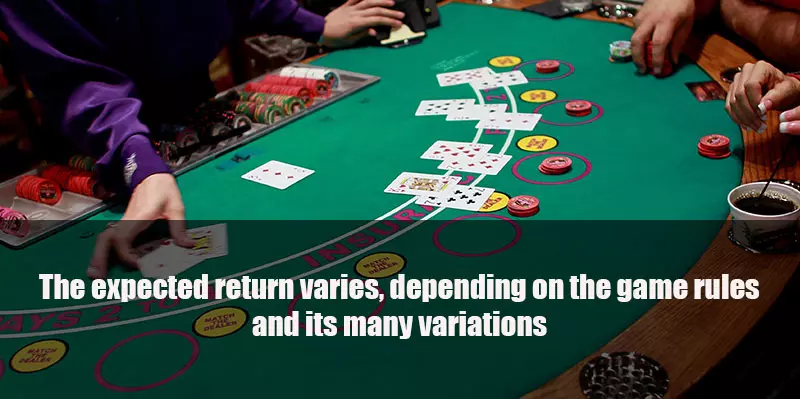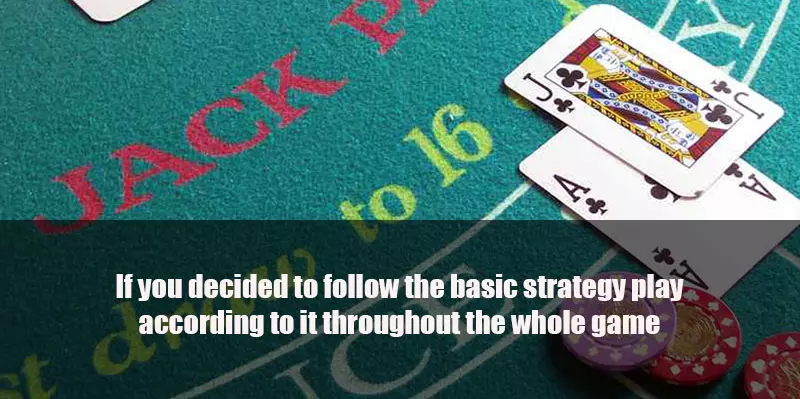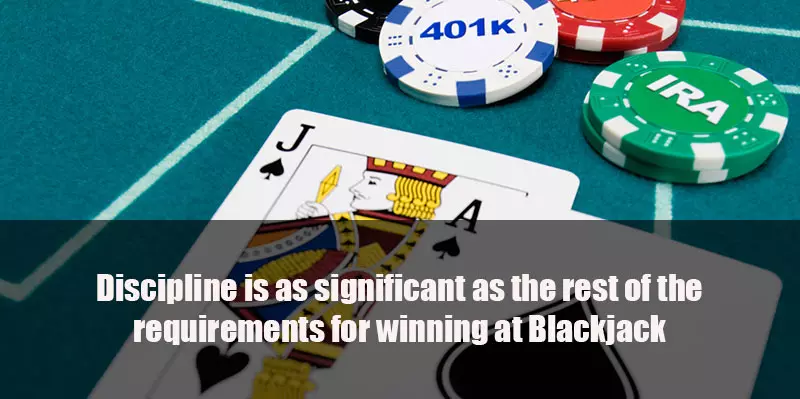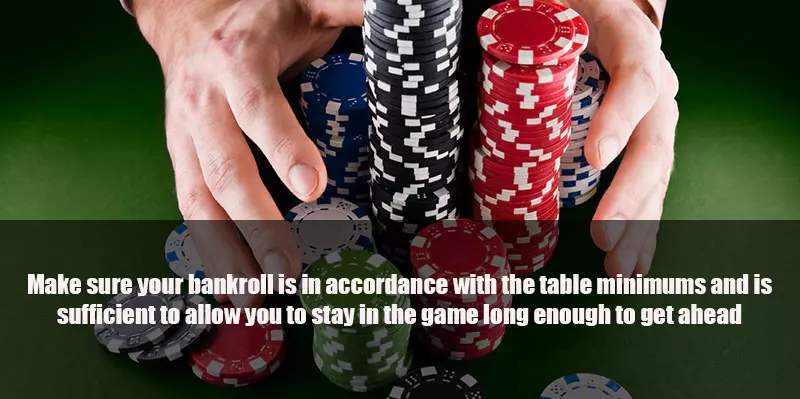Blackjack is one of the most played casino games all over the world as it offers players the chance to apply their skills and knowledge, turn the tables, and win. Throughout the years, a number of strategies have been developed, specially designed to help them gain an advantage over the casino.
However, in order to achieve this result there are many important factors which should be taken into account. When it comes to playing blackjack, every small detail matters and can make the difference between winning and losing.
If players want to become consistent winners, they need to understand the major role of their bankroll as well as their money management skills. The only way to make a profit and successfully keep it is to be aware of the percentage return the game has and know how to benefit from it.
This is really important due to the fact the casino always has a built-in advantage and the odds are not in favour of basic strategy players before they have even started playing. This is the reason why they need to be disciplined enough to leave the table when they are ahead.
What is ROI
In the gambling world, the abbreviation ROI stands for Return On Investment which, as the name hints, is an indicator for the success and the loss of a particular amount of wagered money for each hand. Thanks to it, they are able to figure out the efficiency of their invested money during the game and therefore, it is considered to be a very useful tool.
Knowing the ROI in advance, they will be able to make wiser choices for their bankroll and even moves. It is another subtlety that is closely related to money management as well as discipline.
The term ROI is borrowed from the financial sector where it denotes the ratio between investors’ net gains and the overall cost of their investment. The larger one’s ROI, the greater the gains they have registered. And vice versa, the lower the ROI, the smaller the person’s profits. In other words, ROI is a measurement of one’s financial performance regardless of whether they invest in stocks, sports betting, or gambling.
Calculating ROI is rather straightforward. The simplest way is to divide your total profits by the overall amount you have staked within a certain timeframe. Assuming you have wagered £10,000 over the course of the last five weeks and have generated winnings of £850, the ROI will be equal to £850 / £10,000 = 0.085. The Return on Investment can also be expressed as a percentage if you multiply it by 100 like so 0.085 x 100 = 8.5%, which is low. ROI needs to exceed 100% or else you are in the red.
Keep in mind that it is not impossible to generate a high Return on Investment over the short run. Professional gamblers succeed in achieving this in the long term. Also, to assess the ROI accurately, one needs to take into account the volume of wagers they have placed.
A person who has achieved ROI of, say, 104% after placing 4,000 wagers is seen as more successful than one with a ROI of 140% over the course of 400 bets. This can be attributed to short-term variance.
Expected Return to Players
The expected return to player (RTP) is a little bit different from the ROI as it is the average money players lose or win each hand they play. The expected return varies, depending on the game rules and its many variations.
Important factors such as whether the dealer hits or stands on soft 17, whether doubling down soft hands is allowed or not, and whether re-splitting is an option are essential to be taken into account. They influence directly the players’ odds and probabilities and can worsen or improve their expected return.

Understandably, when players are deprived of the option to double down in certain cases or re-split, their expected return will be decreased. This is the reason why it is recommended when they choose a casino and a table to look for rules and variations of the game that favour them.
For instance, if single-deck blackjack is available, it is a variation that is considered to be very advantageous for the players. However, they should always have a look in advance at the payout of this version as more and more casinos start to pay 6 to 5. If this is the case, they need to refrain from playing as their chances of making a profit are nil.
The theoretical return to player is basically the same thing as expected value and is normally expressed in percentages. The RTP can also be treated as a reflection of the house edge. To calculate it, you can subtract the house edge of your chosen blackjack variation from 100%.
So for example, if a given game yields 0.36% in favour of the casino, its theoretical return would be 100% – 0.36% = 99.64%. In turn, this means the game will return approximately £99.64 per every £100 wagered in the long run. The house gets to keep the rest.
However, this happens after thousands of hands are played. Due to variance and the law of small numbers, it is possible to win or lose much larger amounts than the long-term RTP indicates. One of the peculiarities that distinguish blackjack from other casino games, like craps or roulette, is that the RTP varies across different variants of 21. For example, a variation like Blackjack Switch has a theoretical return of 99.87% whereas Atlantic City Blackjack offers lower long-term returns of 99.65%.
Such discrepancies are due to the fact that both the house edge and the theoretical return of blackjack are additive, i.e. each rule in place gives or takes from the house edge. It follows different rulesets yield different theoretical returns in blackjack. Of course, the higher the RTP percentage, the better for the basic strategy player.
Another thing worth mentioning is that theoretical returns and expected value fluctuate depending on what hand you get versus a given dealer upcard. Some hands, like 16 vs. 10, offer negative returns in the long term and you will be in the red no matter how you play them unless you know how to count cards.
Also important is to consider the availability of side bets in some online and terrestrial variants of 21. As a general rule, such proposition wagers are introduced to boost the house’s take from table games like blackjack. All side wagers, without exception, have considerably higher house edges than those basic strategy players combat in the main game.
In turn, this reduces the theoretical return to player of said side bets. By how much precisely depends on the side wager’s payout. Let’s use Perfect Pairs as an example since this is the most popular group of blackjack side wagers.
Felt’s online version of this variation, for instance, yields a theoretical return to player of 99.63% in the base game, which is quite decent. However, the RTP of the Perfect Pairs side bet drops to 93.89% for a house edge of 6.11%. Because of this, basic strategy players should refrain from playing these side bets on a consistent basis.
The same goes for progressive blackjack variations where usually players are required to make side bets to become eligible for winning the progressive jackpots. The house holds a significantly larger edge on those.
The Cost of Basic Strategy Errors and Their Effect on the RTP
When comparing the RTPs and house edges while choosing a blackjack variation, you should keep in mind that the listed figures assume perfect basic strategy play. In other words, if you play haphazardly, your theoretical return will be lower than the listed percentage. The more playing errors one makes, the greater the casino’s edge gets.

Bad players end up paying for every strategy mistake they commit. The monetary penalties differ depending on the severity of the violation. Thus, always buying insurance against the dealer’s ace will take away 0.23% from your long-term theoretical return. If you never double down, you decrease your return by 1.6%.
Hitting hard hands versus low-value cards will cost you 3.2% in terms of RTP. Splitting and resplitting ten-value cards translate into an 8% reduction in the theoretical return while standing on hard hands against high-value dealer upcards leads to a 3% reduction. If you combine all these playing mistakes and commit them consistently as some people do, the house edge would grow from the standard 0.50% to the whopping 16%. Thus, your long-term theoretical return would drop from £99.50 to £84 per every £100 wagered.
Figuring Out Your Expected Return and EV
Unlike basic strategy players, who inevitably end up in the red provided that they play long enough, card counters are able to generate a positive expected return, or EV, in the long run. The term EV denotes expected value, i.e. the amount a blackjack player is expected to lose or win over time. In this sense, it is similar to the theoretical return to player.
So how do you know what your EV is when you play blackjack? If you are a basic strategy player, this is not all that difficult to figure out. First, you must find out what the theoretical return to player of your chosen blackjack variant is. This is a very easy task if you play online since most software providers would list the RTP percentage in their games’ Help sections.
Then you subtract the RTP from 100% to determine what house edge you are up against. Once you figure this out, you multiply the house edge by your average wager and then by the number of hands per hour. The latter will be higher for online players due to the more dynamic pace inherent to RNG-based blackjack games.

Provided that you play against a 0.50% house edge and flat bet £10 per hand for one hundred hands per hour, your long-term hourly EV would be (-0.005) x £10 x 100 = -£5. You will surely experience streaks where you win or lose a couple of hundred pounds within the same timeframe but this is all due to short-term variance. However, if you go through enough hands, the math of the game will work out and you will give £5 per hour to the casino.
This is not the case where card counters are concerned, though, the reason being there is no house edge. The opposite applies since card counters have an advantage over the casino. Nonetheless, the formula for calculating expected value is the same.
Most advantage players implement simulation software, like Norm Wattenberger’s Casino Verite, that tells them exactly how much expected value they would generate in the long term. They, too, experience streaks and register different short-term wins or losses until sooner or later they reach their expectation.
Setting Appropriate Win Goals Is the Key to Winning
Blackjack is a casino game and as such, it always has a built-in advantage, regardless of its variations and rules. If players want to make a profit, they need to have good money management skills and discipline. One of the most important things is to set a realistic and achievable percentage return for every game which is in accordance with their bankroll and play till they reach it.
For instance, if players bring £300 to the casino table, their win goal should be around £60. The only way to make a profit and manage to keep it is if they are content with winning small amounts every time rather than win big once.
As already indicated, it is not a game which favours the players, even if they know the basic strategy and have the needed discipline and skills, their chances of winning each hand will be less than 50/50 if we have to be accurate. This is the reason why they should set small win goals and withdraw when they reach them. This way, they will be able to not only enjoy the game but also make a profit in the long term.
Gambling Discipline
ROI and Return to Player
Blackjack Casinos
Blackjack Mobile Casinos
Blackjack Switch
Importance of the Bankroll
The bankroll plays a crucial role as it directly influences the players’ choices during the game. Every time they go to a casino, they can afford to bring a different amount of money which is the reason why their win goals and loss limits should be set beforehand every day.
Moreover, this eliminates the chances that their bets and moves will be influenced by their current feelings or emotions. In order to prevent themselves from losing their entire bankroll in one go, players need to divide it according to the sessions they would like to take part in.
Understandably, the bigger their bankroll is, the higher their win goals can be. However, this strategy might draw any unwanted attention from the casino and cause them troubles.
This doesn’t mean that players shouldn’t bring a decent bankroll if they could as they can greatly benefit from it. Thanks to it, they will be able to achieve their win goals faster and play according to the basic strategy without any concerns that they won’t be able to bet enough.
Moreover, not bringing enough money will inevitably result in losing all of it. Before players sit at a table, they should make sure their bankroll is in accordance with the table minimums and is sufficient to allow them to stay in the game long enough to get ahead.
If this is not the case, they should refrain from playing as the result will be always the same – a certain loss. The best possible approach if they want to make a profit out of this game, is to be content with small expected returns and achieve them as often as possible.

Conclusion
The bottom line is that if players want to become consistent winners and beat the casino, they should strive for small returns rather than big ones. It is worth mentioning that their bankroll plays a crucial role as their loss limits and win goals are determined according to it.
If players don’t have enough money to withstand the game’s variance, they should refrain from going to the casino as they are doomed to a certain loss. The expected return and ROI change according to the game rules and its variations and this is the reason why they should pay extra attention to them prior to sitting at a table.